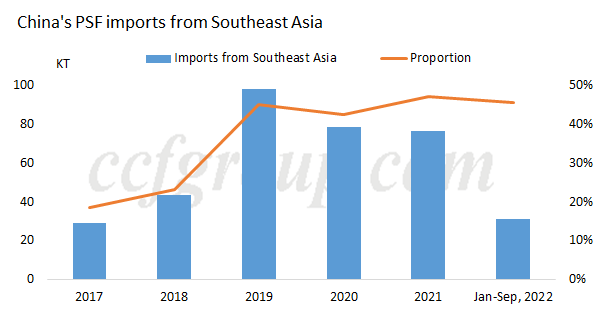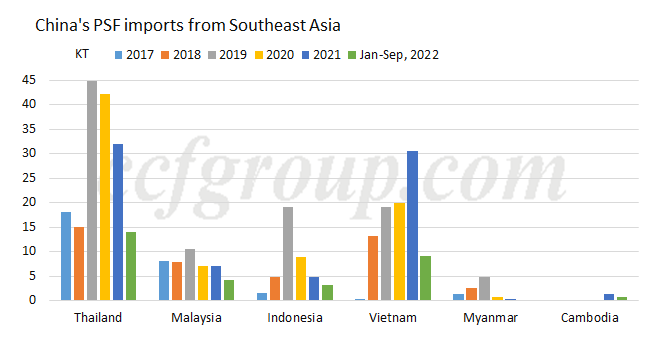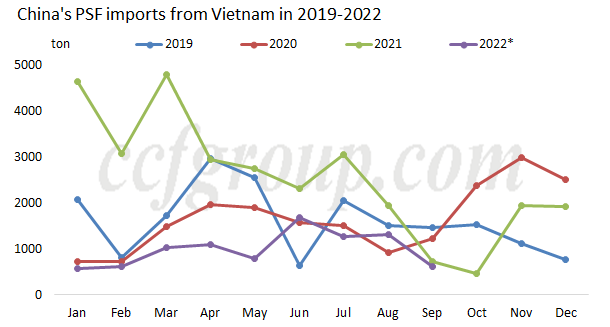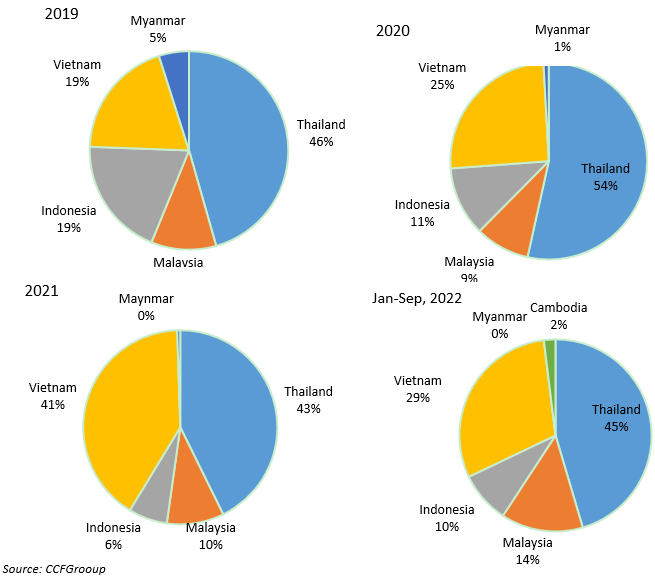China's PSF imports from Southeast Asia and Africa in Jan-Sep, 2022
In Sep, 2022, PSF exports of China were 86,700 tons, up 38.5% year on year and down 1% month on month, and imports were 7,800 tons, down 13.4% year on year and up 7.4% month on month.
According to the China Customs, in the first three quarters of 2022, China's uncombed polyester staple fiber exports were 746.4kt, up 8.6% year on year, and imports were67.7kt, down 46.1% year on year. Compared with the same period in 2019, exports declined by 0.1% and imports reduced by 58.5%. The exports in Jan-Sep had no big difference with the same period of 2019, and for the whole year, the exports may reach about 1 million tons. With large capacity expansion in China and the weak demand, the large reduction of imports is within the anticipation.

HS code 55032000 is synthetic staple fibers, of polyesters, not carded, including virgin PSF and recycled PSF. And the imports from Southeast Asia and African are mainly the recycled PSF. The following are the changes in recent years.
In 2022, imports from Southeast Asia hit a new low in recent three years, especially the imports from Vietnam, have declined significantly.

In the import origins of PSF, Myanmar appeared in 2017, and the overall imports were not much. In 2019, one HC re-PSF production line in Hangzhou was moved to Myanmar, and has not started production till now. In 2020, imports declined sharply. In 2021, operation was unstable affected by the epidemic and Feb 1 coup, and the products mainly sold to Europe and the United States. Imports were only 378 tons in 2021, and in 2022, there was still no imports by now.
Vietnam started to exert force in 2018. Following the solid waste ban, domestic plants moved to foreign countries gradually. Vietnam has gathered solid re-PSF and a few HC virgin PSF plants. Imports in 2018 soared to 13,113 tons and reached 30,567 tons in 2021. It was mainly attributed to the demand recovery, larger price spread between virgin PSF and recycled PSF and the speculative demand around the Lunar New Year. In 2020, a few new plants engaged solid re-PSF put into operation, with a capacity of 50 tons per day, and the products are mainly delivered to China, so the monthly imports from Vietnam are higher year on year. In May 2021, Vietnam started the strict lock-down measures with the outbreak of epidemic. Till Sep, there were 729 tons imported, and 459 tons imported in Oct, the lowest level in recent two years. With the relaxation of power rationing and control of epidemic, imports in Nov-Dec climbed up obviously to 2,000 tons. In addition, affected by surging sea freight, China-origin cheap fibers were hard to sell to Vietnam, and HC re-PSF sales were smooth in Vietnam.
From Jan, 2022, imports from Vietnam reduced largely, lower than the same period of previous years every month. In Jan-Sep, 2022, imports totaled 8,999 tons, down 65.7% year on year. The advantages of Vietnam are the low labor costs and the less influences from trade war, but due to no accompanying upstream and downstream units, especially the high dependence on PTA and MEG imports, the costs are high. Moreover, the products are mainly exported to Europe and U.S., but sea freight is high last year, so some investors transfer to Mexico.

Imports from Thailand were 45kt in 2019, and then reduced gradually. The imports put certain impact on Guangdong market. There were still new capacities, including HC re-PSF, hollow PSF and colored yarn. A few plants plan to start up this year. In Jan-Sep, 2022, imports were 13,926 tons. In early Sep, HC re-PSF was mostly at 7,100-7,200yuan/mt in China, while prices in Thailand were at $1,050-1,070/mt, about 8,500-8,600yuan/mt, so the imports are supposed to reduce.
In 2021, the imports from Cambodia were 1,261 tons. In Jan-Sep, 2022, imports were only 664 tons.
Imports from Southeast Asia were 98,390 tons in 2019, 78,779 tons in 2020, 76,245 tons in 2021 and 30,928 tons in Jan-Sep, 2022.

The African market has gradually risen in recent years, especially in 2018-2019, some domestic production lines have also been transferred to Africa. Therefore, the exports to China has increased rapidly from 2019. Imports in 2020 have grown by 28%, mainly from South Africa and Nigeria, but in 2021 imports from South Africa shrank sharply affected by the riots, which caused disruptions of plant operation. Imports from Nigeria in Mar 2021 were good, reaching 2,728 tons. But the imports from Africa were zero in the fourth quarter of 2021. In 2022, there were only imports from Uganda of 455 tons. Exports to China are supposed to be limited this year, mostly to Europe. Recycled PSF capacities continue to expand in Africa benefited from the edge in sea freight to Europe and no high tax. Exports to China may be limited this year.
| China's PSF imports from Africa (incl. virgin PSF and re-PSF) | |||||||
| Unit: tons | 2016 | 2017 | 2018 | 2019 | 2020 | 2021 | Jan-Sep, 2022 |
| South Afria | 0 | 230 | 24 | 5586 | 6122 | 638 | 0 |
| Nigeria | 0 | 0 | 0 | 5667 | 9069 | 6397 | 0 |
| Tanzania | 0 | 0 | 0 | 643 | 0 | 0 | 0 |
| Egypt | 0 | 0 | 102 | 39 | 0 | 0 | 0 |
| Ethiopia | 0 | 0 | 0 | 0 | 98 | 0 | 0 |
| Uganda | 455 | ||||||
| Total | 0 | 230 | 126 | 11935 | 15289 | 7035 | 455 |
Recycled chemical fiber market outside China is still under capacity expansion this year, and the overseas trades may increase, squeezing the export shares of China, but China is still the world largest recycled chemical fiber production base. China local capacity expansion continues as well this year, but impacted by the epidemic and weak market sentiment, some units are delayed to be put into operation in the fourth quarter of this year or next year.
- Top keywords
- Cotton Price
- Cotton Futures Price
- Cotton Futures
- CZCE
- PTA Futures Price
- Chemical Fiber
- Polyester Prices
- Wool price
- PTA Futures
- Shengze Silk
- China
- Yarn Price
- price
- China Textile City
- Fibre Price
- Benzene Price
- Cotton
- Index
- Cotton Index
- PTA
- fabric price
- NYMEX
- Top 10
- textile industry
- Spot Cotton
- Cotton Yarn
- Polyester Price
- Futures
- PTA Price
- cotton yarn price

